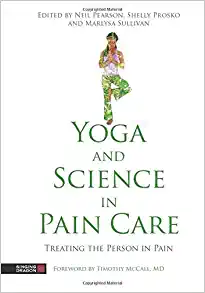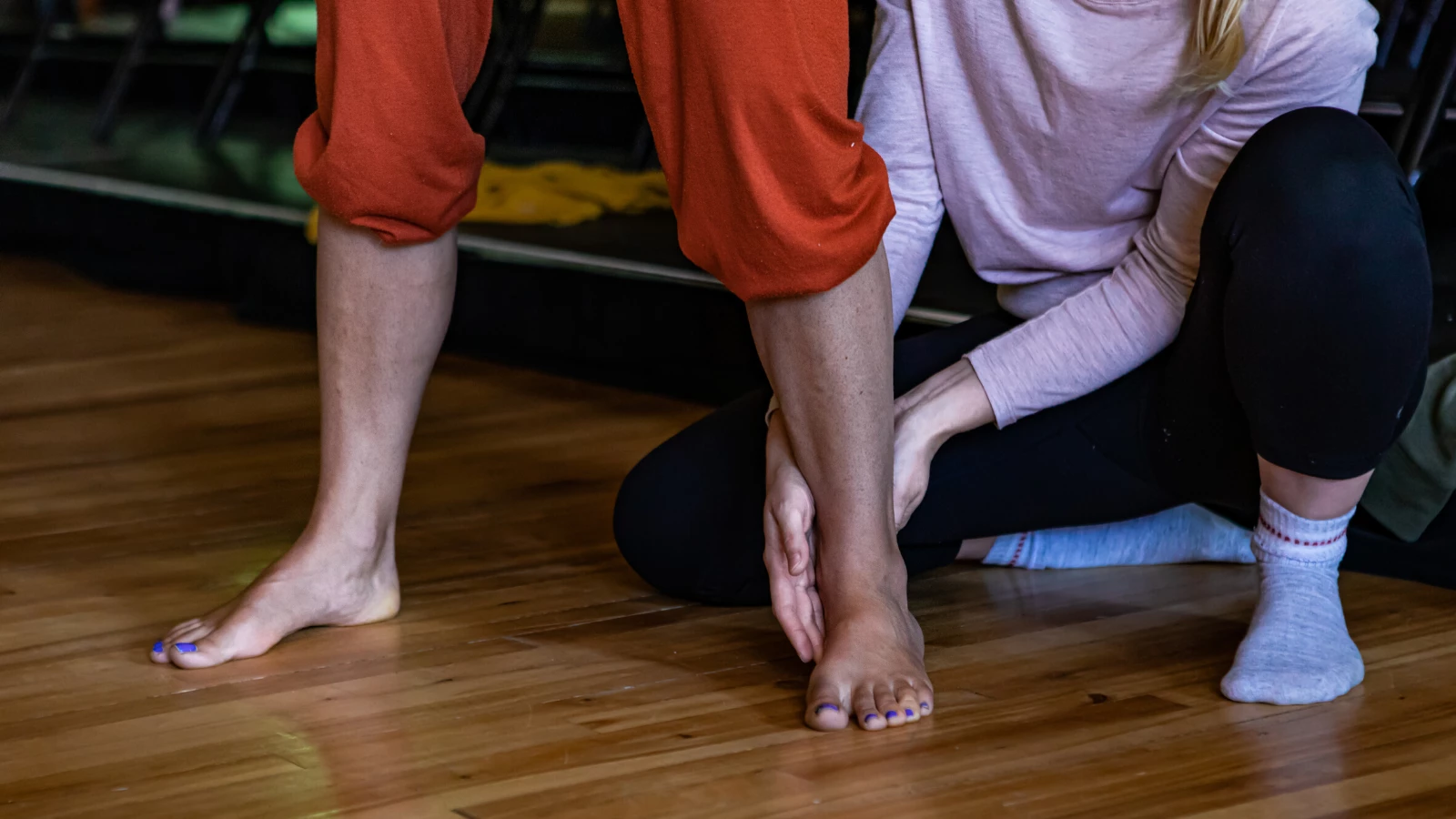Book Review: Yoga and Science in Pain Care

The Centers for Disease Control and Prevention estimates that 20 percent of American adults are living with chronic pain, defined as experiencing pain most or every day for a minimum of six months. While the standard of care has been managing the pain, often with prescription pain relievers, both doctors and patients alike are beginning to look toward alternative long-term solutions to pain management, including yoga and meditation.

Yoga And Science in Pain Care: Treating The Person In Pain, edited by Neil Pearson, Shelly Prosko and Marlysa Sullivan, is a compilation of the latest research into pain care. This comprehensive text covers the most current research in pain care, as well as a multi-disciplinary approach to caring for not just the pain, but for the whole person as well.
The authors are intentional in their usage of the term pain care, rather than pain management.
“Pain care intends to suggest that helping people in pain is not only a medical issue but also a health and wellbeing issue. Effective pain care is about assisting and caring for the person when pain persists, and there are situations in which the pain can be changed rather than managed.” (Pg. 19)
The book begins with Joletta Belton sharing, in her own words, her story of chronic pain and how it transformed her life. In one moment, Belton was a strong, athletic firefighter. During a routine call, she stepped down from her fire truck and felt a weird twinge in her hip. Years of debilitating pain, losing her career, surgeries, and a myriad of doctors eventually led her to seek a better way to care for herself.
Yoga: A Multidimensional Approach to Pain
As Steffany Moonaz, author of the chapter on “Current Research In Yoga and Pain,” says, “People may come to yoga to change their pain, but stay to change their lives, which may ultimately change their pain.”
Yoga And Science in Pain Care: Treating The Person In Pain isn’t a prescription on how to alleviate pain. Instead, it combines scientific research with yoga practices to offer treatment options. Anecdotal evidence shows that when patients feel empowered, they are better able to live with and function with their chronic pain.
 Dr. Lori Rubenstein Fazzio emphasizes body awareness when working with her clients. Fazzio, the author of the chapter “Body Awareness, Bhavana and Pratyahara,” says that those living with chronic pain develop an altered body schema. Often people will describe the painful body part in negative terms, thus reinforcing the painful mind-body connection.
Dr. Lori Rubenstein Fazzio emphasizes body awareness when working with her clients. Fazzio, the author of the chapter “Body Awareness, Bhavana and Pratyahara,” says that those living with chronic pain develop an altered body schema. Often people will describe the painful body part in negative terms, thus reinforcing the painful mind-body connection.
Fazzio uses what she calls a “Virtual MRI” to help people get rid of their negative emotions around their pain. By visualizing the body part in pain, the client describes what she sees or feels. Next, without actually moving the body part, the client visualizes pain-free movement. This visualization practice–simplified here–is repeated under the guidance of an experienced practitioner until a more positive body schema is achieved. Often, this leads to an improved range of motion or even reported decreased pain.
Other chapters in the book focus on nutrition, pranayama, addiction, and compassion for those in pain.
The Role of Compassion in Pain Care
Shelly Prosko, the author of the chapter “Compassion in Pain Care,” says that compassion in health care enhances the quality of care, improves patient outcomes, and improves the management of people with chronic illness, as well as many other desirable outcomes.
Prosko speaks to the importance of compassion in both the medical practitioner to the patient, as well as the patient to herself. She recommends a pranayama practice called the * “Resurrection Breath” that she often teaches her clients to help them shift their attention from focusing on the past, or worrying about the future, to the present moment.

How To Practice Resurrection Breath
-
Sitting comfortably with your head facing forward, inhale through your nose.
-
Turning your head to look over your left shoulder, double exhale out of your mouth, making a “haa haa” sound.
-
As you inhale, bring your head back to the center.
-
On your next exhale, turn your head over your right shoulder and blow out through pursed lips.
-
Inhale and return your head to the center.
-
Exhale and bow your chin to your heart center, allowing yourself to connect to the present moment.
While the yoga research cited in the book is comprehensive and encouraging, research on the benefits of yoga carries some inherent limitations.
Dr. Timothy McCall, in the foreword, writes:
“Almost all studies of yoga are of short duration due to the chronic shortage of funding for such research. Studies lasting a few weeks or months will tend to underestimate the benefits of a practice, which builds in effectiveness slowly over time. Further, due to the requirements of evidence-based medicine, yoga studies are almost always of standardized treatment protocols, in which every person is prescribed the same exact same poses, breathing techniques, etc. These protocols lack the personalization that skilled yoga therapists insist boosts both the effectiveness and safety of the practice prescribes.”
Yoga And Science in Pain Care: Treating The Person In Pain is an excellent resource for both the current scientific studies available, as well as the multidisciplinary approaches becoming more available to those living with chronic pain.
Dr. McCall says, “Understanding the causes of suffering and how it can be lessened has been a central focus of yoga for thousands of years. The time is right to apply this wisdom to the millions of chronic pain sufferers whose need for it is pressing.”
 Jennifer Williams-Fields E-RYT 200 is passionate about writing, yoga, traveling, public speaking, and being a fabulous single momma to six super kids. Doing it all at one time, however, is her great struggle. She has been teaching yoga since 2005 and writing since she first picked up a crayon. Although her life is a sort of organized chaos, she loves every minute of the craziness and is grateful for all she’s learned along the way. Her first book, “Creating A Joyful Life: The Lessons I Learned From Yoga and My Mom,” is now available on Amazon. She has had her essays featured on Yahoo! and Dr. Oz The Good Life. She is a regular writer for Elephant Journal Magazine, Your Tango, and YogaUOnline. See more from Jennifer at jenniferwilliamsfields.com.
Jennifer Williams-Fields E-RYT 200 is passionate about writing, yoga, traveling, public speaking, and being a fabulous single momma to six super kids. Doing it all at one time, however, is her great struggle. She has been teaching yoga since 2005 and writing since she first picked up a crayon. Although her life is a sort of organized chaos, she loves every minute of the craziness and is grateful for all she’s learned along the way. Her first book, “Creating A Joyful Life: The Lessons I Learned From Yoga and My Mom,” is now available on Amazon. She has had her essays featured on Yahoo! and Dr. Oz The Good Life. She is a regular writer for Elephant Journal Magazine, Your Tango, and YogaUOnline. See more from Jennifer at jenniferwilliamsfields.com.
 Shelly Prosko, PT, CPI, C-IAYT
Shelly Prosko, PT, CPI, C-IAYT
Shelly Prosko is a physiotherapist, yoga therapist, educator, and pioneer of PhysioYoga with over 20 years of experience integrating yoga into rehabilitation with a focus on chronic/persistent pain, pelvic health, and professional burnout. She guest lectures at yoga and physiotherapy programs, presents at yoga and medical conferences globally, contributes to academic research, offers onsite and online continuing education courses and mentorship for yoga and healthcare professionals, and is a Pain Care U Yoga Trainer. She maintains a clinical practice in Sylvan Lake, Canada, and believes that cultivating meaningful connections, compassion, and joy can be powerful contributors to recovery and well-being. Please visit www.physioyoga.ca to learn more.
 Neil Pearson, PT, MSc (RHBS), BA-BPHE, C-IAYT, ERYT500
Neil Pearson, PT, MSc (RHBS), BA-BPHE, C-IAYT, ERYT500
Neil Pearson is a physiotherapist and Clinical Assistant Professor at the University of British Columbia. He is an experienced yoga teacher, yoga therapist, and creator of the Pain Care Yoga training programs for health professionals and yoga therapists. Neil is the founding chair of the Physiotherapy Pain Science Division in Canada, recipient of the Canadian Pain Society’s Excellence in Interprofessional Pain Education award, author of a conversational patient education book, and faculty in multiple yoga therapist training programs. Neil develops innovative resources, collaborates in research, and serves as a mentor for health professionals and yoga practitioners seeking to enhance their therapeutic expertise. www.paincareu.com
 Marlysa Sullivan, PT, C-IAYT
Marlysa Sullivan, PT, C-IAYT
Marlysa Sullivan is a physical therapist and yoga therapist specializing in working with people living with chronic pain conditions. She is a professor at the Maryland University of Integrative Health in the Masters of Science in Yoga Therapy as well as Emory University, where she teaches the integration of yoga into physical therapy practice. Her research interests focus on developing an explanatory and theoretical framework for yoga therapy to assist its utilization in both research and clinical contexts. She is actively involved in helping grow the profession of yoga therapy through international collaborations and teaching.
Resources
Neil Pearson, Shelly Prosko, and Marlysa Sullivan are co-editors/authors of the textbook Yoga and Science in Pain Care: Treating the Person in Pain by Singing Dragon publishing. For more information, including the list of all contributing authors to the book, please visit https://physioyoga.ca/yoga-and-science-in-pain-care-treating-the-person-in-pain.
*Pearson, Lisa (2016) “The Resurrection Breath. Advanced Pain Care Yoga Training.” In: Oral Teachings of Goswami Kriyananda 1997-2009.



